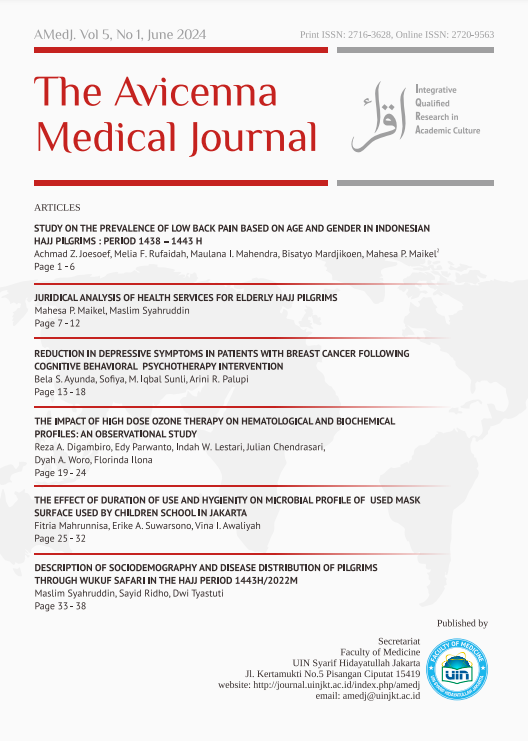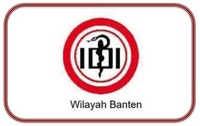The Impact of High Dose Ozone Therapy on Hematological and Biochemical Profiles : An Observational Study
DOI:
https://doi.org/10.15408/avicenna.v5i1.34859Keywords:
High Dose Ozone Therapy, hematological alterations, biochemical alterations, oxidative stress markersAbstract
Background: Ozone therapy, namely High Dose Ozone Therapy (HDO), has become a versatile medical treatment in several clinical settings. Although it is becoming more well acknowledged, there is still a lack of extensive evidence about the impact of this on hematological and biochemical indicators. This study seeks to address this void by examining the consequences of this phenomenon in a clinical environment.
Method: An observational study was done, which followed a structured approach, comprising a total of 100 patients who were selected from the SMC Clinic. Hematological and biochemical indices were evaluated before and after ozone therapy sessions to analyze blood parameters. Two blood samples were obtained at two specific time points: prior to the commencement of the ozone therapy (T0) and after the therapy was finished (T1).
Results: Substantial alterations were noted in both hematological and biochemical parameters after the therapy. The hematological changes observed in this study showed a substantial rise in the red blood cell count (p=0.009), hemoglobin levels (p=0.004), and hematocrit (p=0.039), along with a decrease in erythrocyte sedimentation rate (ESR) (p=0.020). Notable biochemical changes were observed, including significant modifications in total plasma protein (TPP) (p=0.008) and lactate levels (p=0.001). Furthermore, there was a noteworthy decrease (p<0.05) in the levels of malondialdehyde (MDA), which is a marker for oxidative stress.
Conclusion: HDO exerts a regulatory influence on crucial hematological, biochemical, and oxidative stress factors. These findings indicate that HDO may have therapeutic benefits for treating chronic disorders and cancer. It can improve blood parameters and reduce oxidative stress. The decrease in markers of oxidative stress, such as MDA, suggests a potential reduction in the likelihood of problems associated with oxidative damage in chronic diseases. Nevertheless, additional research is required to validate these findings, investigate their wider therapeutic implications, and comprehend the long-term consequences and safety of HDO therapy.
References
Martínez-Sánchez G. Practical aspects in ozone therapy: Study of the ozone concentration in the ozonized saline solution. Official Journal of Aepromo (Spanish Association of Medical Professionals in Ozone Therapy). 2020;10(1):55–68.
Menéndez S, Cepero J, Borrego L. Ozone therapy in cancer treatment: State of the art. Ozone Sci Eng. 2008 Nov;30(6):398–404.
Tang S, Xu B, Pang H, Xiao L, Mei Q, He X. Ozonated Water Inhibits Hepatocellular Carcinoma Invasion and Metastasis by Regulating the HMGB1/NF-κB/STAT3 Signaling Pathway. J Hepatocell Carcinoma. 2023;10:203–15.
Zeng J, Lei L, Zeng Q, Yao Y, Wu Y, Li Q, et al. Ozone therapy attenuates NF-ΚB–mediated local inflammatory response and activation of th17 cells in treatment for psoriasis. Int J Biol Sci. 2020;16(11):1833–45.
Krzyzanowski B, Searles Nielsen S, Turner JR, Racette BA. Fine Particulate Matter and Parkinson Disease Risk among Medicare Beneficiaries. Neurology. 2023 Nov 21;101(21):E2058–67.
J. Smith A, Oertle J, Warren D, Prato D. Ozone Therapy: A Critical Physiological and Diverse Clinical Evaluation with Regard to Immune Modulation, Anti-Infectious Properties, Anti-Cancer Potential, and Impact on Anti-Oxidant Enzymes. Open J Mol Integr Physiol. 2015;05(03):37–48.
Shrivastava S, Singh N, Nigam AK, Chandel SS, Shrivastava R, Kumar S. Comparative study of hematological parameters along with effect of chemotherapy and radiotherapy in different stages of breast cancer. Int J Res Med Sci. 2016 Dec 19;5(1):311.
Ur Rehman W, Maroof L, Khan MH, Israr M, Shah Q, Rehman U, et al. Effect of Cupping Therapy on Biochemical and Hematological Parameters. National Journal of Life and Health Sciences. 2023 Dec 30;2(2):76–80.
Luongo M, Brigida AL, Mascolo L, Gaudino G. Possible therapeutic effects of ozone mixture on hypoxia in tumor development. Vol. 37, Anticancer Research. International Institute of Anticancer Research; 2017. p. 425–36.
Li Y, Pu R. Ozone Therapy for Breast Cancer: An Integrative Literature Review. Vol. 23, Integrative Cancer Therapies. SAGE Publications Inc.; 2024.
Smith N, Wilson A, Gandhi J, Vatsia S, Khan S. Ozone therapy: An overview of pharmacodynamics, current research, and clinical utility. Vol. 7, Medical Gas Research. Medknow Publications; 2017. p. 212–9.
Luongo M, Brigida AL, Mascolo L, Gaudino G. Possible therapeutic effects of ozone mixture on hypoxia in tumor development. Vol. 37, Anticancer Research. International Institute of Anticancer Research; 2017. p. 425–36.
Krzyzanowski B, Searles Nielsen S, Turner JR, Racette BA. Fine Particulate Matter and Parkinson Disease Risk among Medicare Beneficiaries. Neurology. 2023 Nov 21;101(21):E2058–67.
Jomova K, Raptova R, Alomar SY, Alwasel SH, Nepovimova E, Kuca K, et al. Reactive oxygen species, toxicity, oxidative stress, and antioxidants: chronic diseases and aging. Vol. 97, Archives of Toxicology. Springer Science and Business Media Deutschland GmbH; 2023. p. 2499–574.
Sadighara P, Shahbazi R, Zirak MR, Mohamadi S, Karami L, Zomorodian N, et al. The content and dietary exposure of Malondialdehyde in industrial and traditional ice cream fats ARTICLE INFO ABSTRACT [Internet]. Vol. 8, J food safe & hyg. 2022. Available from: http://jfsh.tums.ac.ir
Jablonowski H, Santos Sousa J, Weltmann KD, Wende K, Reuter S. Quantification of the ozone and singlet delta oxygen produced in gas and liquid phases by a non-thermal atmospheric plasma with relevance for medical treatment. Sci Rep. 2018 Dec 1;8(1).
Pelinsari SM, Sarandy MM, Vilela EF, Novaes RD, Schlamb J, Gonçalves RV. Ozone Exposure Controls Oxidative Stress and the Inflammatory Process of Hepatocytes in Murine Models. Vol. 13, Antioxidants. Multidisciplinary Digital Publishing Institute (MDPI); 2024.
Sumida JM, Hayashi AM. Ozone therapy in veterinary medicine: clinical indications and techniques. Vol. 16, Acta Veterinaria Brasilica. Universidade Federal Rural do Semi-Arido; 2022. p. 294–304.








